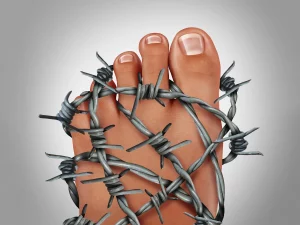Introduction
Living with small fiber neuropathy can be a silent agony, affecting every aspect of daily life. From the tingling sensations to the burning pain, individuals with this condition endure a myriad of symptoms that often go unnoticed by others. In this comprehensive guide, we delve deep into the world of small fiber neuropathy, exploring its causes, symptoms, diagnosis, treatment options, and coping mechanisms. You Need To Know About Other Health Problems Or Solutions (Allergies or Snoring)
Understanding Small Fiber Neuropathy
Small fiber neuropathy is a neurological disorder that affects the small, unmyelinated nerve fibers responsible for transmitting sensory signals such as pain and temperature. While the exact cause of small fiber neuropathy is often unknown, it can be associated with underlying conditions such as diabetes, autoimmune diseases, infections, or genetic mutations.

Causes of Small Fiber Neuropathy
| Causes | Description |
|---|---|
| Diabetes Mellitus | Diabetes mellitus, especially poorly controlled diabetes, is one of the most common causes of small fiber neuropathy. |
| Autoimmune Diseases | Certain autoimmune diseases, such as lupus, Sjögren’s syndrome, and rheumatoid arthritis, can trigger an immune response that attacks the body’s own tissues, including the nerves. |
| Infections | Infections caused by viruses, bacteria, or other pathogens can sometimes lead to small fiber neuropathy. |
| Genetic Mutations | In some cases, small fiber neuropathy may be inherited due to genetic mutations that affect the structure or function of the nerves. |
Symptoms of Small Fiber Neuropathy
The symptoms of small fiber neuropathy can vary widely from person to person, but commonly include:
- Burning pain
- Tingling or prickling sensations
- Numbness
- Hypersensitivity to touch
- Electric shock-like sensations
- Itching
- Temperature dysregulation
These symptoms often begin in the feet and lower legs but can gradually spread to other areas of the body, such as the hands and arms.

Diagnosis and Evaluation
Diagnosing small fiber neuropathy can be challenging due to its diverse range of symptoms and underlying causes. However, healthcare providers utilize a combination of clinical assessments, nerve conduction studies, skin biopsy, and laboratory tests to evaluate and confirm the diagnosis.
Clinical Assessment
Healthcare providers start by conducting a thorough medical history and physical examination to assess the patient’s symptoms, risk factors, and any underlying conditions that may be contributing to neuropathy.
Nerve Conduction Studies
Nerve conduction studies (NCS) are commonly used to evaluate the function of larger, myelinated nerve fibers. While NCS may be normal in small fiber neuropathy, they can help rule out other neuropathic conditions.
Skin Biopsy
Skin biopsy is considered the gold standard for diagnosing small fiber neuropathy. During this procedure, a small piece of skin is removed from the lower leg and examined under a microscope to quantify the density of small nerve fibers.
Laboratory Tests
Laboratory tests, including blood tests and genetic testing, may be performed to identify underlying conditions associated with small fiber neuropathy, such as diabetes, autoimmune diseases, or genetic mutations.

Treatment Options
While there is currently no cure for small fiber neuropathy, various treatment modalities aim to manage symptoms, improve quality of life, and prevent further nerve damage. Treatment approaches may include:
Medications
- Pain Medications: Over-the-counter pain relievers such as acetaminophen or nonsteroidal anti-inflammatory drugs (NSAIDs) may help alleviate mild to moderate neuropathic pain.
- Antidepressants: Tricyclic antidepressants (TCAs) and selective serotonin-norepinephrine reuptake inhibitors (SNRIs) are often prescribed to manage neuropathic pain by altering the perception of pain signals in the brain.
- Anticonvulsants: Medications such as gabapentin and pregabalin are commonly used to treat neuropathic pain by stabilizing overactive nerve cells.
Topical Treatments
- Capsaicin Cream: Topical capsaicin cream derived from chili peppers can provide temporary pain relief by desensitizing nerve endings in the skin.
- Lidocaine Patches: Lidocaine patches may be applied to the affected area to numb the skin and alleviate neuropathic pain.
Physical Therapy
Physical therapy techniques such as stretching exercises, massage therapy, and transcutaneous electrical nerve stimulation (TENS) may help improve muscle strength, flexibility, and overall function in individuals
Lifestyle Modifications
- Foot Care: Proper foot care is essential for individuals with fiber neuropathy to prevent complications such as foot ulcers or infections. This includes regular inspection of the feet, wearing supportive footwear, and practicing good hygiene.
- Pain Management Strategies: Employing relaxation techniques, mindfulness meditation, and stress-reducing activities can help individuals cope with chronic neuropathic pain and improve their overall well-being.

Coping with Small Fiber Neuropathy
Living with fiber neuropathy can be challenging, but there are strategies and resources available to help individuals cope with the condition and maintain a fulfilling lifestyle:
Support Groups
Joining support groups or online communities for individuals with neuropathy can provide valuable emotional support, practical advice, and a sense of belonging.
Education and Advocacy
Educating oneself about fiber neuropathy, its symptoms, treatment options, and self-care strategies empowers individuals to actively participate in their healthcare decisions and advocate for their needs.
Holistic Approaches
Exploring complementary and alternative therapies such as acupuncture, yoga, tai chi, and dietary supplements may offer additional relief and improve overall well-being.
Emotional Wellness
Prioritizing mental and emotional wellness through activities such as counseling, therapy, relaxation techniques, and hobbies can help individuals manage stress, anxiety, and depression associated with chronic pain and illness.
Conclusion
Living with presents unique challenges, but with proper diagnosis, treatment, and support, individuals can effectively manage their symptoms and lead fulfilling lives. By raising awareness, promoting research, and advocating for improved access to care, we can work towards better understanding and management of this debilitating condition. Remember, you are not alone in your journey, and there are resources and communities available to support you every step of the way.




